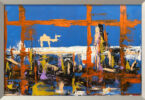Maan Jalal
A pair of ancient ornamental pillars, separated for 240 years, have been reunited at Louvre Abu Dhabi, on the occasion of the 50-year anniversary of the UAE’s diplomatic relationship with the Republic of Malta.
Louvre Abu Dhabi on Thursday announced the two loans, known as cippi, from the National Museum of Archaeology, Valletta in Malta and Musee du Louvre, Paris. The two pillars, which date to the 3rd or 2nd century BC, will be on display together for the first time since 1782.
For the next year they will be part of Gallery 5, devoted to Civilisation and Empires, as part of a wider representation of the intersections between the East and West.
Maria Camilleri Calleja, Ambassador of Malta to the UAE, said the reunification of the pillars, “separated by fate but reunited by design”, was symbolic of Maltese-Emirati relations.
“Although geographically apart and diverse, their will to work together has brought them to co-operate on many levels by people of good will, politically, commercially, in sports, on people-to-people levels, in research and innovation and not least in the cultural sector,” Calleja added.
“2023 is an important year for both our countries, Malta, and the United Arab Emirates, as we celebrate our Golden Jubilee – 50 years of diplomatic relations forged in 1973 – which continue to amplify year after year. Malta is honoured and privileged to have a solid relationship with the Department of Culture and Tourism Abu Dhabi, we can now see the fruits of this relationship through the work of two auspicious institutions being Heritage Malta and Louvre Abu Dhabi.”
:quality(70)/cloudfront-eu-central-1.images.arcpublishing.com/thenational/3IIQTLLW4ZF2JI4OUDH2DGZ4BE.jpg)
In the ancient Greco-Roman world, cippi were frequently inscribed with information – serving as milestones, funerary monuments, border demarcations and even devoted to divinities in temples. The duo on temporary display at Louvre Abu Dhabi until next June are believed to have supported surfaces used to hold incense-burning dishes or to present offerings.
Perched on top of rectangular bases and decorated with identical Phoenician and Greek inscriptions, they represent the remarkable transference of religion, language and culture through the vast Phoenician commercial Mediterranean trade network.
In the same way that the Rosetta Stone was used to crack open the Egyptian hieroglyphic code in 1822, the cippi of Malta were instrumental in French epigraphist Abbe Barthelemy’s efforts to decipher the Phoenician alphabet in 1758.
Manuel Rabate, director of Louvre Abu Dhabi, said the reunion of the pillars at Louvre Abu Dhabi was a “testament to our mission of telling stories of cultural connections”.
“For the first time in over 240 years, these cippi will be displayed together, marking a significant moment in the preservation and celebration of our shared heritage,” he said. “These loans showcase the power of art to bridge the gaps across times, geographies, and civilisations.”
The pillars will be on display at Louvre Abu Dhabi until June 2024.
Courtesy: thenationalnews







